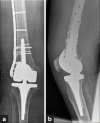Results of titanium locking plate and stainless steel cerclage wire combination in femoral fractures
- PMID: 24133304
- PMCID: PMC3796917
- DOI: 10.4103/0019-5413.118200
Results of titanium locking plate and stainless steel cerclage wire combination in femoral fractures
Abstract
Background: Some in vitro studies warn combining different metals in orthopedic surgery. The aim of this study is to determine the impact of combining titanium and stainless steel on bone healing and the clinical course of patients undergoing internal fixation of femoral fractures.
Materials and methods: 69 patients with femoral fractures had polyaxial locking plate osteosynthesis. The locking plate was made of a titanium alloy. Two different cohorts were defined: (a) sole plating and (b) additional stainless steel cerclage wiring. Postoperative radiographs and clinical followup were performed at 6 weeks, 3 months and 12 months.
Results: Cohorts A and B had 36 and 33 patients, respectively. Patient demographics and comorbidities were similar in both groups. In two cases in cohort A, surgical revision was necessary. No complication could be attributed to the combination of titanium and stainless steel.
Conclusion: The combination of stainless steel cerclage wires and titanium plates does not compromise fracture healing or the postoperative clinical course.
Keywords: Cerclage wire; fracture healing; galvanic corrosion; locking plate; stainless steel; titanium.
Conflict of interest statement
Figures


References
-
- Hoffmeier KL, Hofmann GO, Muckley T. Choosing a proper working length can improve the lifespan of locked plates: A biomechanical study. Clin Biomech (Bristol, Avon) 2011;26:405–9. - PubMed
-
- Disegi JA. Titanium alloys for fracture fixation implants. Injury. 2000;31(Suppl 4):14–7. - PubMed
-
- Carls J, Kohn D, Rossig S. A comparative study of two cerclage systems. Arch Orthop Trauma Surg. 1999;119:67–7. - PubMed
-
- Bostrom MP, Asnis SE, Ernberg JJ, Wright TM, Giddings VL, Berberian WS, et al. Fatigue testing of cerclage stainless steel wire fixation. J Orthop Trauma. 1994;8:422–8. - PubMed
-
- Shaw JA, Daubert HB. Compression capability of cerclage fixation systems: A biomechanical study. Orthopedics. 1988;11:1169–7. - PubMed
LinkOut - more resources
Full Text Sources
Other Literature Sources
